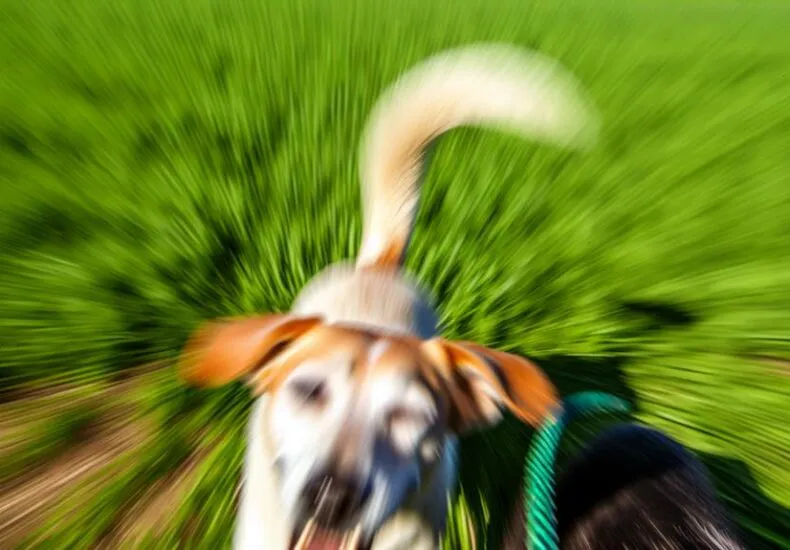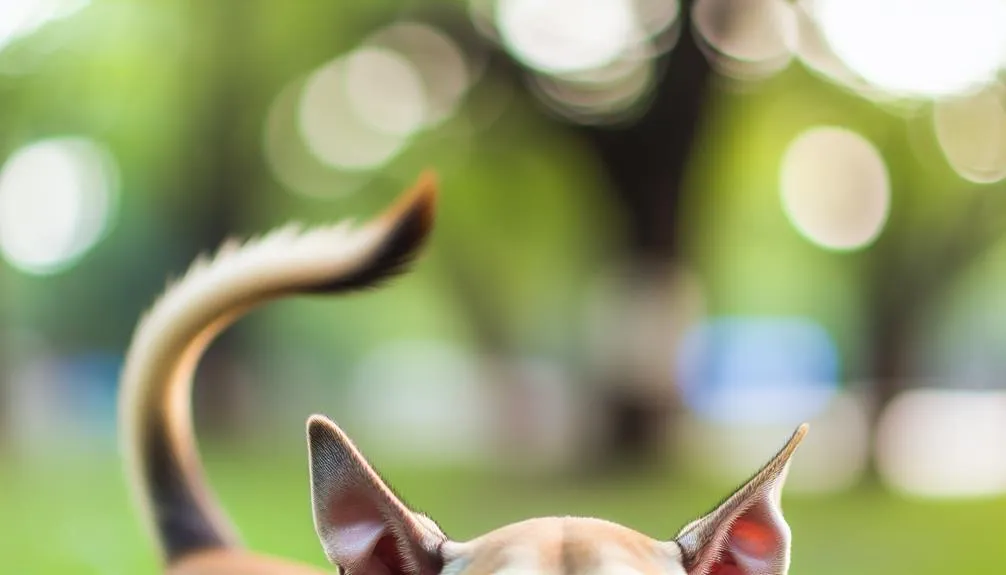
Does a Dog Wagging His Tail Always Mean He’s Happy
You might think a dog wagging his tail is a clear sign of happiness, but it's not always that straightforward. Tail movements can signal a variety of emotions, from excitement to anxiety, and even aggression. For instance, the speed and height of the wag can provide vital clues about what your dog is really feeling. So, how can you tell the difference? Understanding the nuances of canine communication is essential, and it might just change the way you perceive your furry friend's emotions. Let's explore this further.
Understanding Tail Wagging Signals
Tail wagging is often seen as a universal sign of a dog's happiness, but the truth is more complex. While many believe that a wagging tail indicates joy, there are several tail wagging myths that can lead to misunderstandings about your dog's emotional state. It's crucial to recognize that tail movements can convey a range of feelings, not just happiness.
When your dog wags its tail, it's actually utilizing a form of emotional intelligence, communicating a variety of signals that can reflect excitement, anxiety, or even aggression. For instance, a fast, high wag might indicate enthusiasm, while a slow, low wag could signify insecurity or submission. Understanding these nuances requires careful observation of your dog's body language in conjunction with the tail movements.
Moreover, context plays a significant role in interpreting these signals. If your dog wags its tail while approaching a new person, it might be excited to make a new friend. Conversely, if the tail is wagging but the dog appears tense or has pinned ears, it could be feeling threatened. By paying attention to these subtle cues, you can gain a deeper insight into your dog's emotional state.
Different Types of Tail Wags
Understanding the different types of tail wags can enhance your ability to interpret your dog's feelings accurately. Tail wagging isn't a one-size-fits-all behavior; each wag tells a unique story about your dog's emotional state. For instance, playful wags typically involve rapid, sweeping motions and are often accompanied by a relaxed body posture. If your dog greets you with these enthusiastic movements, it's a sign they're ready for fun and interaction.
On the other hand, excited greetings often manifest as a vigorous wagging that may come from side to side or even a circular motion. This type of wagging often indicates a high level of enthusiasm, especially when you return home or when they see a favorite person. You might notice your dog's entire body engaging in this behavior, showcasing their joy and keenness to connect.
However, not all tail wags signal happiness or playfulness. A slow wag with a lowered tail may suggest uncertainty or nervousness. As you observe your dog, pay attention to the context and the accompanying body language. The more you understand how your dog communicates through their tail, the better equipped you'll be to respond to their needs. By recognizing the nuances of tail wags, you can strengthen your bond and make sure your dog feels understood and secure in their environment.
Body Language and Context

When you observe your dog wagging its tail, it's essential to contemplate the tail's position and the rest of its body language. A high, fast wag can indicate excitement, while a low wag might suggest submission or uncertainty. By paying attention to these cues in context, you can better understand your dog's emotions and intentions.
Tail Position Variations
A dog's tail position can reveal a wealth of information about its emotional state and intentions. When you observe a dog, pay attention to how high or low its tail is held. A tail held high often signifies confidence and excitement, while a low tail can indicate submission or fear. If the tail is tucked between the legs, this is a strong emotional cue that the dog feels threatened or anxious.
Additionally, the angle at which the tail is held can provide further insight. A relaxed tail position, held horizontally, usually suggests a calm and comfortable demeanor. In contrast, a stiff and high tail can indicate alertness or aggression. You might notice the tail wagging vigorously—this can mean a mix of excitement and friendliness, but be cautious; not all wagging indicates happiness.
Other Body Signals
While observing a dog's tail can provide important clues about its feelings, other body signals are equally vital for interpreting its overall mood and intentions. For instance, a dog's ears can reveal a lot; ears held back might indicate fear or submission, while ears perked up often signify curiosity or excitement. When you notice a dog leaning toward you, it could be seeking affection or showing interest.
Body posture also plays an essential role in tail communication. A dog standing tall with a straight back may display confidence, whereas a hunched posture could signal anxiety or insecurity. Pay attention to the dog's facial expressions, as emotional cues like a relaxed mouth or soft eyes generally indicate contentment, while a stiff face or bared teeth can suggest aggression or discomfort.
Context matters too—an excited wagging tail in a familiar environment might mean joy, but the same tail movement in a strange setting could indicate nervousness. By considering these body signals alongside tail movements, you can gain a more thorough understanding of your dog's feelings and needs, fostering a deeper bond between you both.
Happy Vs. Nervous Wags
Understanding the nuances of a dog's tail wagging can reveal a lot about its emotional state. While many people assume a wagging tail signifies a happy dog, it's important to differentiate between a happy tail and a nervous tail. The way a dog wags its tail can provide insights into its feelings and intentions.
A happy tail typically involves broad, sweeping movements, often accompanied by a relaxed body posture. You might notice the tail wagging high and fast, signaling joy and excitement, especially when your dog sees you after a long day. This kind of wagging is usually a clear indication that your dog is comfortable and content in its environment.
On the other hand, a nervous tail exhibits different characteristics. If you observe your dog wagging its tail low, or in a more hesitant manner, it could indicate anxiety or fear. A nervous tail might flick or wag slowly, often accompanied by other signs of unease, such as cowering or a tucked body posture. In these situations, your dog may be unsure about what's happening around it or feeling threatened.
Recognizing the distinction between a happy tail and a nervous tail is vital for understanding your dog's emotional landscape. By paying attention to these subtle cues, you can foster a more supportive environment that addresses your dog's needs, ensuring it feels secure and happy in your presence.
Tail Position and Meaning

When observing a dog's tail position, it's important to recognize that it serves as a significant indicator of their emotional state. The height at which a dog holds its tail can reveal a lot about how they're feeling. For instance, a high tail often signifies confidence and happiness, while a low tail may indicate submission or fear. If you see a dog with its tail tucked between its legs, it's a strong signal that they're anxious or frightened.
Tail speed also plays a key role in understanding your dog's emotions. A rapidly wagging tail typically denotes excitement or joy, but it's crucial to take into account the context. Sometimes, a dog may wag its tail quickly while appearing tense or stiff, which could suggest agitation or a need for space. This contrast highlights the importance of not solely relying on tail movement but also observing the dog's overall body language.
It's worth noting that different breeds may have varying tail positions and movements, so familiarity with your dog's usual behavior can enhance your understanding. For instance, a Greyhound's tail may not wag as enthusiastically as a Labrador's, but that doesn't mean they aren't happy.
Training Your Dog's Emotions
Recognizing your dog's emotional signals through tail movement and body language is just the beginning of fostering a deeper connection with them. To truly train your dog's emotions, you need to focus on emotion recognition. This involves understanding their feelings and responding to them appropriately. For instance, if your dog shows signs of anxiety when meeting new people, acknowledging this emotion can help you address it effectively.
Using positive reinforcement is essential in this training process. When your dog exhibits calm behavior in situations that usually cause anxiety, reward them with treats or praise. This not only reinforces their positive responses but also helps them associate these situations with pleasant experiences. Over time, your dog will learn to navigate their emotions better, reducing stress and fostering a happier demeanor.
It's also important to create a safe environment where your dog feels secure to express their emotions. Encourage them to communicate their feelings through consistent training exercises, focusing on commands that promote calmness and relaxation. This can include teaching them to go to a designated spot when they feel overwhelmed.
Frequently Asked Questions
Can Tail Wagging Indicate Aggression in Dogs?
Yes, tail wagging can indicate aggression in dogs. You should observe tail position significance; a high, stiff wag often signals aggressive body language, while a relaxed wag typically suggests friendliness. Always consider the dog's overall demeanor.
Do All Dog Breeds Wag Their Tails Similarly?
Did you know that over 340 dog breeds exist, each showcasing unique tail language? Breed differences can greatly influence how tails are wagged, reflecting various emotions and intentions, not just happiness. Understanding this is essential.
How Can I Tell if My Dog Is Uncomfortable?
To tell if your dog's uncomfortable, observe their body language. Look for stress signals like tucked tails, pinned ears, or avoidance behavior. Recognizing these signs can help you guarantee your dog's well-being and comfort.
What Should I Do if My Dog Is Wagging Nervously?
If your dog's wagging nervously, don't assume it's just excitement. Observe their body language. Use calming techniques like gentle petting or creating a safe space to help ease their anxiety and promote relaxation.
Is Tail Wagging a Sign of Submission?
Tail wagging can indeed indicate submission in dogs. It's part of their tail communication, reflecting body language that shows they're feeling non-threatening. Observing the entire context helps you understand your dog's emotions better.
Conclusion
So, the next time you see a dog wagging his tail, pause for a moment. Is it really happiness you're witnessing? Consider the context, the tail's position, and the dog's overall demeanor. What might seem like joy could mask anxiety or uncertainty. By understanding these signals, you can foster a deeper connection with your furry friend. Remember, it's not just about the wag; it's about the whole story your dog is trying to tell you.
You may also like
Archives
Calendar
| M | T | W | T | F | S | S |
|---|---|---|---|---|---|---|
| 1 | 2 | 3 | 4 | 5 | 6 | |
| 7 | 8 | 9 | 10 | 11 | 12 | 13 |
| 14 | 15 | 16 | 17 | 18 | 19 | 20 |
| 21 | 22 | 23 | 24 | 25 | 26 | 27 |
| 28 | 29 | 30 | ||||
Leave a Reply